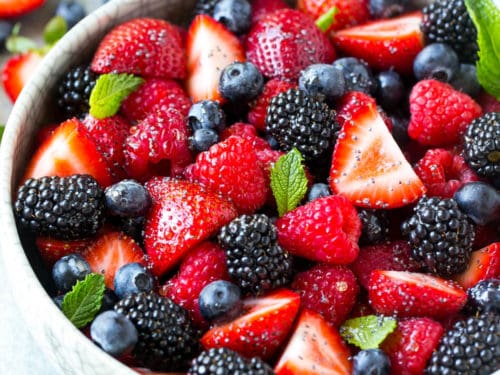三大莓類的營養益處
莓類含有多種營養物質,當中不少具有抗氧化的特性,例如酚類化合物。這篇文章的目的是介紹三種在香港最常見的莓類的營養,分別是藍莓、草莓和桑莓,並討論它們對糖尿病患者的益處。
藍莓
基於藍莓的健康功用,它已成為大眾其一的「超級食物」。藍莓是多酚豐富的來源,包括花青素。花青素常藏於莓類的表皮層,擔當天然食物的顏色。流行病學和臨床研究表明,食用富含花青素的食物,尤其是藍莓,與降低糖尿病患的風險和胰島素的抵抗有關。[1-15]另外,藍莓含有大量維他命A、C和E,具有抗氧化和抗炎的功效。[16]它的膳食纖維還可幫助降低壞膽固醇和血管硬化的風險。[17]
草莓
草莓是維他命C和鉀質的膳食來源,食用1.5杯分別已攝取了88%和11%的每日建議攝取量。[18]它富含生物活性酚類化合物,例如類黃酮和酚酸,當中的花青素高達60-80克(以每100克的草莓作為單位,其他莓類每100克含有0.24-1.56克花青素)。[17]草莓被指出對自由基的破壞具保護性,有效抑制壞膽固醇的氧化和有助預防癌症。[19,20]此外,證據顯示草莓可抑制炎症和血小板聚集,這些都與減少高血壓和中風風險有關。其高纖、高多酚和低GI的特性總合有助增加胰島素的敏感性和減少餐後血糖的上升。[18]
桑莓
桑莓包含多種可減少心血管疾病的酚類,也被指出具有降血糖、降血脂等作用。[21]它的多酚包括白藜蘆醇(resveratrol)和氧白藜蘆醇(oxyresveratrol)被顯示出能有效地保護腦部神經細胞,可能有助預防神經系統疾病如帕金森氏症和阿滋海默氏症。[22]桑莓同時含有某些物質可抑制碳水化合物的分解,進而降低葡萄糖的吸收以抑制餐後血糖上升的水平。[23-27]
雖然這三種莓類對糖尿病患者有多種好處,但終究它們含有果糖,不能一次進食過量。下表列出把一份碳水化合物(10克)換算成各莓類的相對數量,以供讀者們參考。
| 莓類 | 一份碳水化合物(10克)的換算 |
| 藍莓 | 半杯(70克) |
| 草莓 | 1.5杯(150克) |
| 桑莓 | 2/3杯(100克) |
參考文獻
- Muraki I., Imamura F., Manson J.E., Hu F.B., Willett W.C., van Dam R.M., Sun Q. Fruit consumption and risk of type 2 diabetes: Results from three prospective longitudinal cohort studies. BMJ. 2013;347:f5001.
- Jennings A., Welch A.A., Spector T., Macgregor A., Cassidy A. Intakes of anthocyanins and flavones are associated with biomarkers of insulin resistance and inflammation in women. J. Nutr. 2014;144:202–208.
- Wedick N.M., Pan A., Cassidy A., Rimm E.B., Sampson L., Rosner B., Willett W., Hu F.B., Sun Q., van Dam R.M. Dietary flavonoid intakes and risk of type 2 diabetes in US men and women. Am. J. Clin. Nutr. 2012;95:925–933.
- DeFuria J., Bennett G., Strissel K.J., Perfield J.W., II, Milbury P.E., Greenberg A.S., Obin M.S. Dietary blueberry attenuates whole-body insulin resistance in high fat-fed mice by reducing adipocyte death and its inflammatory sequelae. J. Nutr. 2009;139:1510–1516.
- Elks C.M., Terrebonne J.D., Ingram D.K., Stephens J.M. Blueberries improve glucose tolerance without altering body composition in obese postmenopausal mice. Obesity. 2015;23:573–580.
- Nair A.R., Elks C.M., Vila J., Del Piero F., Paulsen D.B., Francis J. A blueberry-enriched diet improves renal function and reduces oxidative stress in metabolic syndrome animals: Potential mechanism of TLR4-MAPK signaling pathway. PLoS ONE. 2014;9:e111976.
- Roopchand D.E., Kuhn P., Rojo L.E., Lila M.A., Raskin I. Blueberry polyphenol-enriched soybean flour reduces hyperglycemia, body weight gain and serum cholesterol in mice. Pharmacol. Res. 2013;68:59–67.
- Seymour E.M., Tanone I.I., Urcuyo-Llanes D.E., Lewis S.K., Kirakosyan A., Kondoleon M.G., Kaufman P.B., Bolling S.F. Blueberry intake alters skeletal muscle and adipose tissue peroxisome proliferator-activated receptor activity and reduces insulin resistance in obese rats. J. Med. Food. 2011;14:1511–1518.
- Takikawa M., Inoue S., Horio F., Tsuda T. Dietary anthocyanin-rich bilberry extract ameliorates hyperglycemia and insulin sensitivity via activation of AMP-activated protein kinase in diabetic mice. J. Nutr. 2010;140:527–533.
- Vuong T., Benhaddou-Andaloussi A., Brault A., Harbilas D., Martineau L.C., Vallerand D., Ramassamy C., Matar C., Haddad P.S. Antiobesity and antidiabetic effects of biotransformed blueberry juice in KKAy mice. Int. J. Obes. (Lond) 2009;33:1166–1173.
- Wu T., Tang Q., Gao Z., Yu Z., Song H., Zheng X., Chen W. Blueberry and mulberry juice prevent obesity development in C57BL/6 mice. PLoS ONE. 2013;8:e77585.
- Hoggard N., Cruickshank M., Moar K.M., Bestwick C., Holst J.J., Russell W., Horgan G. A single supplement of a standardised bilberry (Vaccinium myrtillus L.) extract (36% wet weight anthocyanins) modifies glycaemic response in individuals with type 2 diabetes controlled by diet and lifestyle. J. Nutr. Sci. 2013;2:e22.
- Li D., Zhang Y., Liu Y., Sun R., Xia M. Purified anthocyanin supplementation reduces dyslipidemia, enhances antioxidant capacity, and prevents insulin resistance in diabetic patients. J. Nutr. 2015;145:742–748.
- Rebello C.J., Burton J., Heiman M., Greenway F.L. Gastrointestinal microbiome modulator improves glucose tolerance in overweight and obese subjects: A randomized controlled pilot trial. J. Diabetes Complicat. 2015;29:1272–1276.
- Stull A.J., Cash K.C., Johnson W.D., Champagne C.M., Cefalu W.T. Bioactives in blueberries improve insulin sensitivity in obese, insulin-resistant men and women. J. Nutr. 2010;140:1764–1768.
- Skrovankova S., Sumczynski D., Mlcek J., Jurikova T., Sochor J. (2015). Bioactive compounds and antioxidant activity in different types of berries. Int. J. Mol. Sci. 16 24673–24706. 10.3390/ijms161024673
- Olas B. Berry Phenolic Antioxidants – Implications for Human Health? Front Pharmacol. 2018 Mar 26;9:78.
18.Giampieri F, Tulipani S, Alvarez-Suarez JM, Quiles JL, Mezzetti B, Battino M. The strawberry: composition, nutritional quality, and impact on human health. Nutrition. 2012;28(1):9‐19.
- Heinonen IM, Meyer AS, Frankel EN. Antioxidant activity of berry phenolics on human low-density lipoprotein and liposome oxidation. J Agric Food Chem. 1998;46(10):4107–4112.
- Hannum SM. Potential impact of strawberries on human health: a review of the science. Crit Rev Food Sci Nutr. 2004;44(1):1–17.
- Shibata Y, Kume N, Arai H, Hayashida K, Inui-Hayashida A, Minami M, Mukai E, Toyohara M, Harauma A, Murayama T, Kita T, Hara S, Kamei K, Yokode M. Mulberry leaf aqueous fractions inhibit TNF-alpha-induced nuclear factor kappaB (NF-kappaB) activation and lectin-like oxidized LDL receptor-1 (LOX-1) expression in vascular endothelial cells. Atherosclerosis, 2007; 193(1): 20-27.
- Chao WW, Kuo YH, Li WC, Lin BF. The production of nitric oxide and prostaglandin E2 in peritoneal macrophages is inhibited by Andrographis paniculata, Angelica sinensis and Morus alba ethyl acetate fractions. J Ethnopharmacol, 2009; 122(1): 68-75.
23.Kimura T, Nakagawa K, Kubota H. Food-grade mulberry powder enriched with1- deoxynojirimycin suppresses the elevation of postprandial blood glucose in humans. J Agri Food Chem, 2007; 55: 5869-5874.
- Bonora E, Muggeo M. Postprandial blood glucose as a risk factor for cardiovascular disease in Type II diabetes: the epidemiological evidence. Diabetologia, 2001; 44: 2107- 2114.
25.Van Der Laar FA, Lucassen PL, Akkermans RP. a-Glucosidase inhibitors for patients with type 2 diabetes: results from a Cochrane systematic review and meta-analysis. Diabetes Care, 2005; 28: 154-163.
26.Dungan KM, Buse JB, Largay J. 1,5-Anhydroglucitol and postprandial hyperglycemia as measured by continuous glucose monitoring system in moderately controlled patients with diabetes. Diabetes Care, 2006; 29: 1214-1219.
27.Nakamura M, Nakamura S, Oku T. Suppressive response of confections containing the extractive from leaves of Morus alba on postprandial blood glucose and insulin in healthy human subjects. Nutr Metab, (Lond). 2009; 6: 29.
.
